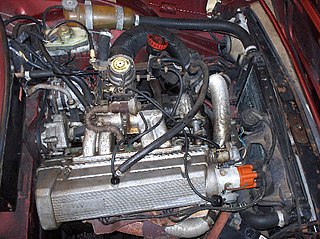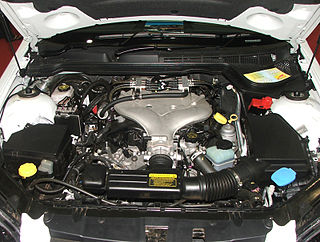Related Research Articles

The diesel engine, named after the German engineer Rudolf Diesel, is an internal combustion engine in which ignition of the fuel is caused by the elevated temperature of the air in the cylinder due to mechanical compression; thus, the diesel engine is called a compression-ignition engine. This contrasts with engines using spark plug-ignition of the air-fuel mixture, such as a petrol engine or a gas engine.

The Wankel engine is a type of internal combustion engine using an eccentric rotary design to convert pressure into rotating motion. The concept was proven by German engineer Felix Wankel, followed by a commercially feasible engine designed by German engineer Hanns-Dieter Paschke. The Wankel engine's rotor, which creates the turning motion, is similar in shape to a Reuleaux triangle, with the sides having less curvature. The rotor spins inside a figure-eight-like epitrochoidal housing around a fixed-toothed gearing. The midpoint of the rotor moves in a circle around the output shaft, rotating the shaft via a cam.
An octane rating, or octane number, is a standard measure of a fuel's ability to withstand compression in an internal combustion engine without causing engine knocking. The higher the octane number, the more compression the fuel can withstand before detonating. Octane rating does not relate directly to the power output or the energy content of the fuel per unit mass or volume, but simply indicates the resistance to detonating under pressure without a spark.

In internal combustion engines, exhaust gas recirculation (EGR) is a nitrogen oxide (NOx) emissions reduction technique used in petrol/gasoline, diesel engines and some hydrogen engines. EGR works by recirculating a portion of an engine's exhaust gas back to the engine cylinders. The exhaust gas displaces atmospheric air and reduces O2 in the combustion chamber. Reducing the amount of oxygen reduces the amount of fuel that can burn in the cylinder thereby reducing peak in-cylinder temperatures. The actual amount of recirculated exhaust gas varies with the engine operating parameters.
A stratified charge engine describes a certain type of internal combustion engine, usually spark ignition (SI) engine that can be used in trucks, automobiles, portable and stationary equipment. The term "stratified charge" refers to the working fluids and fuel vapors entering the cylinder. Usually the fuel is injected into the cylinder or enters as a fuel rich vapor where a spark or other means are used to initiate ignition where the fuel rich zone interacts with the air to promote complete combustion. A stratified charge can allow for slightly higher compression ratios without "knock," and leaner air/fuel ratio than in conventional internal combustion engines.

Motor oil, engine oil, or engine lubricant is any one of various substances used for the lubrication of internal combustion engines. They typically consist of base oils enhanced with various additives, particularly antiwear additives, detergents, dispersants, and, for multi-grade oils, viscosity index improvers. The main function of motor oil is to reduce friction and wear on moving parts and to clean the engine from sludge and varnish (detergents). It also neutralizes acids that originate from fuel and from oxidation of the lubricant (detergents), improves the sealing of piston rings, and cools the engine by carrying heat away from moving parts.
In spark-ignition internal combustion engines, knocking occurs when combustion of some of the air/fuel mixture in the cylinder does not result from propagation of the flame front ignited by the spark plug, but when one or more pockets of air/fuel mixture explode outside the envelope of the normal combustion front. The fuel–air charge is meant to be ignited by the spark plug only, and at a precise point in the piston's stroke. Knock occurs when the peak of the combustion process no longer occurs at the optimum moment for the four-stroke cycle. The shock wave creates the characteristic metallic "pinging" sound, and cylinder pressure increases dramatically. Effects of engine knocking range from inconsequential to completely destructive.
The GM Ecotec engine, also known by its codename L850, is a family of all-aluminium inline-four engines, displacing between 1.2 and 2.5 litres. Confusingly, the Ecotec name was also applied to both the Buick V6 Engine when used in Holden Vehicles, as well as the final DOHC derivatives of the previous GM Family II engine; the architecture was substantially re-engineered for this new Ecotec application produced since 2000. This engine family replaced the GM Family II engine, the GM 122 engine, the Saab H engine, and the Quad 4 engine. It is manufactured in multiple locations, to include Spring Hill Manufacturing, in Spring Hill, Tennessee, with engine blocks and cylinder heads cast at Saginaw Metal Casting Operations in Saginaw, Michigan.

The GM High Feature engine is a family of modern DOHC V6 engines produced by General Motors. The series was introduced in 2004 with the Cadillac CTS and the Holden Commodore (VZ).
Indirect injection in an internal combustion engine is fuel injection where fuel is not directly injected into the combustion chamber.
Homogeneous Charge Compression Ignition (HCCI) is a form of internal combustion in which well-mixed fuel and oxidizer are compressed to the point of auto-ignition. As in other forms of combustion, this exothermic reaction produces heat that can be transformed into work in a heat engine.
In internal combustion engines, water injection, also known as anti-detonant injection (ADI), can spray water into the incoming air or fuel-air mixture, or directly into the combustion chamber to cool certain parts of the induction system where "hot points" could produce premature ignition. In jet engines — particularly early turbojets or engines in which it is not practical or desirable to have an afterburner — water injection may be used to increase engine thrust, particularly at low-altitudes and at takeoff.

Two-stroke oil is a special type of motor oil intended for use in crankcase compression two-stroke engines, typical of small gasoline-powered engines.

Various alcohols are used as fuel for internal combustion engines. The first four aliphatic alcohols are of interest as fuels because they can be synthesized chemically or biologically, and they have characteristics which allow them to be used in internal combustion engines. The general chemical formula for alcohol fuel is CnH2n+1OH.

Bi-fuel vehicles are vehicles with multifuel engines capable of running on two fuels. The two fuels are stored in separate tanks and the engine runs on one fuel at a time. On internal combustion engines, a bi-fuel engine typically burns gasoline and a volatile alternate fuel such as natural gas (CNG), LPG, or hydrogen. Bi-fuel vehicles switch between gasoline and the other fuel, manually or automatically. A related concept is the dual-fuel vehicle which must burn both fuels in combination. Diesel engines converted to use gaseous fuels fall into this class due to the different ignition system.

The Hesselman engine is a hybrid between a petrol engine and a diesel engine. It was designed and introduced in 1925 by Swedish engineer Jonas Hesselman.
Brake-specific fuel consumption (BSFC) is a measure of the fuel efficiency of any prime mover that burns fuel and produces rotational, or shaft power. It is typically used for comparing the efficiency of internal combustion engines with a shaft output.
In the automotive industry, engine downsizing is the practice of utilizing smaller combustion engines over larger ones of the same power capacity when manufacturing vehicles. It is the result of car manufacturers attempting to provide more efficient vehicles that emit fewer emissions, often mandated by legislative standards. The term generally relates to traditional internal combustion engines powered by petrol or diesel.
The SRM Engine Suite is an engineering software tool used for simulating fuels, combustion and exhaust gas emissions in internal combustion engine applications. It is used worldwide by leading IC engine development organisations and fuel companies. The software is developed, maintained and supported by CMCL Innovations, Cambridge, U.K.
Partially premixed combustion (PPC), also known as PPCI or GDCI is a modern combustion process intended to be used in internal combustion engines of automobiles and other motorized vehicles in the future. Its high specific power, high fuel efficiency and low exhaust pollution have made it a promising technology. As a compression-ignition engine, the fuel mixture ignites due to the increase in temperature that occurs with compression rather than a spark from a spark plug. A PPC engine injects and premixes a charge during the compression stroke. This premixed charge is too lean to ignite during the compression stroke – the charge will ignite after the last fuel injection ends near TDC. The fuel efficiency and working principle of a PPC engine resemble those of Diesel engine, but the PPC engine can be run with a variety of fuels. Also, the partially premixed charge burns clean. Challenges with using gasoline in a PPC engine arise due to the low lubricity of gasoline and the low cetane value of gasoline. Use of fuel additives or gasoline-diesel or gasoline-biodiesel blends can mitigate the various problems with gasoline.
References
- 1 2 Chapman, E.; Davis, R.; Studzinski, W.; Geng, P. (2014). "Fuel Octane and Volatility Effects on the Stochastic Pre-Ignition Behavior of a 2.0L Gasoline Turbocharged DI Engine". SAE Int. J. Fuels Lubr. 7 (2): 379–389. doi:10.4271/2014-01-1226.
- ↑ "Aggressive engine downsizing held back by low-speed preignition problems?". Autoblog. Auto Blog. Retrieved 2015-02-02.
- ↑ Okada, Y.; Miyashita, S.; Izumi, Y.; Hayakawa, Y. (2014). "Study of Low-Speed Pre-Ignition in Boosted Spark Ignition Engine". SAE Int. J. Engines. 7 (2): 584–594. doi:10.4271/2014-01-1218.
- ↑ Anthony Martyr; Michael Alexander Plint (2012). Engine Testing: The Design, Building, Modification and Use of Powertrain Test Facilities (Google Books excerpt). Elsevier. ISBN 978-0080969497.
- ↑ "Aggressive engine downsizing held back by low-speed preignition problems?" . Retrieved 2015-02-02.
- ↑ "SwRI to Launch Low-Speed Preignition Prevention Program (P3) Consortium" . Retrieved 2015-02-02.
- ↑ "General Motors Oil Specifications". oilspecifications.org. Retrieved 2019-08-09.
- ↑ "GM's Global Engine Oil Specification dexos®" . Retrieved 2015-02-02.
- ↑ "PC-11 and GF-6: New engines drive change in oil specs". Archived from the original on 2013-10-24. Retrieved 2015-02-02.
- ↑ https://www.api.org/products-and-services/engine-oil/eolcs-categories-and-classifications/oil-categories#tab-gasoline
- ↑ Zaccardi, Jean-Marc; Serrano, David (2014). "A Comparative Low Speed Pre-Ignition (LSPI) Study in Downsized SI Gasoline and CI Diesel-Methane Dual Fuel Engines". SAE International Journal of Engines. 7 (4): 1931. doi:10.4271/2014-01-2688.
- ↑ Fuels and Lubes "F+L Week 2014 Conference & Exhibition" . Retrieved 2015-02-02.
{{cite web}}: Check|url=value (help) - ↑ "SwRI to Launch Low-Speed Preignition Prevention Program (P3) Consortium" . Retrieved 2015-02-02.
- ↑ "Pre-ignition Prevention Program Consortium" . Retrieved 2015-02-02.
- ↑ Afton Chemical (2014). "The Holistic Approach to Engine Oil Performance" . Retrieved 2015-02-02.